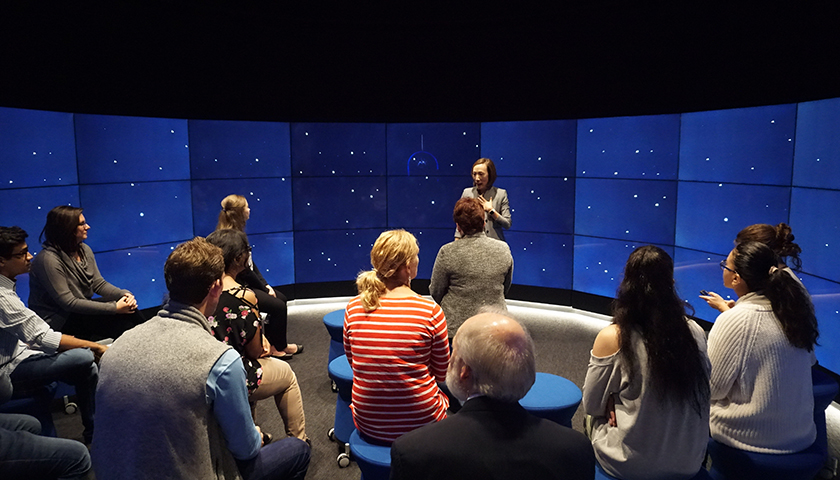Suffolk Students See the Future of Healthcare

And the answer is: It’s helping transform healthcare through technology.
Question: What is Watson?
More than six years after appearing on “Jeopardy!” and beating two of the game show’s best-ever players, IBM’s Watson has taken up residence in Cambridge to pursue a decidedly more sober topic: healthcare.
With its massive computing power, Watson can analyze huge amounts of data much more efficiently than humans can. It can process hundreds of medical journals, white papers, and patient records faster than any doctor. Even more, it can identify patterns across all those sources and enable medical professionals to make connections they might not otherwise see.
A visit to Watson Healthcare, headquartered near Kendall Square, was just one of several trips healthcare administration students from the Sawyer Business School have taken this fall through the “Innovation: The Future of Healthcare” course. The students have been learning how players across the healthcare industry identify, create, pursue, and support or impede opportunities for innovation.
“Innovation is driving healthcare,” says Rick Gregg, director of Suffolk’s programs in Healthcare Administration. “Our students are learning about the many sources and types of innovation—both in the classroom and at places like Watson Healthcare.”
Watson Healthcare
Healthcare is a hot topic these days. There are the battles in Washington over “Repeal and Replace.” There’s the fact that the United States spends more on healthcare per person than any other country in the world: over $10,000 per person, as of 2016, according to the Department of Health and Human Services. And consider that, by one estimate, the doubling time of medical knowledge in 2020 is projected to be a scant 0.2 years—just 73 days. (In 1950, it was thought the doubling rate was 50 years.)
Understanding this very big, very complicated topic and where it’s going would seem to be essential for every healthcare professional. That’s why the class has been getting out in the field to places like Watson Healthcare, Spaulding Rehabilitation Hospital, the Partners Connected Health Conference, and Boston Children’s Hospital.
“This class gives us insight into the types of innovation we’ll see as administrators and the new innovation that we can expect to see in the near future,” says class member Alexis Canto Aldridge, MHA ’19. “For example, last week we learned about a contact lens for diabetic patients that can detect blood glucose through your tears. It’s such an interesting class.”
#futureofhealthcare
Considering what a morass healthcare has become, finding true solutions to improving delivery of care can be a challenge. But they do exist. One of them is telemedicine, something Mike Bayeh, a recent Suffolk MHA graduate, knows about firsthand. As a telemedicine and e-consultation specialist at RadNet in Los Angeles, he helps develop solutions that use technology to improve the delivery of care.
“With virtual healthcare, we’re able to provide a more patient-centered delivery model. The patient spends 80 percent more time with the provider in a virtual visit than they would during a normal office visit,” Bayeh says. “The ‘Future of Healthcare’ course discusses different solutions like telemedicine and different ways we can tackle these problems.”
In other words, the future is now, and it’s happening in a Suffolk classroom.
An elusive goal?
It may seem like chasing unicorns to ever think you can really, truly understand where healthcare is headed. But as Gregg points out, some of the “future” topics he taught in the course a few years ago are the reality today.
“Innovations that were recently thought to be impossible, such as gene therapy for combating cancers, are opening up whole new ways of treating diseases and prolonging life,” Gregg says. “And innovations such as Fitbit and the Apple Watch enable consumers to monitor their own health and share that information with healthcare providers so they, too, can monitor their patients’ health.”
The takeaways from this innovative course? The speed of new developments in healthcare is astounding. IBM Watson Health is just one incredible example. And on that visit to Kendall Square, Gregg’s students actually witnessed the present and future of healthcare.
Contact
Greg Gatlin
Office of Public Affairs
617-573-8428
Ben Hall
Office of Public Affairs
617-573-8092



